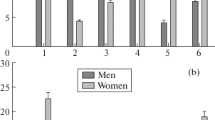Abstract
We determined natural antibodies (n-Abs) to the regulators of the main systems of biochemical homeostasis: β-endorphin, serotonin, dopamine, histamine, orphanin, angiotensin, GABA, glutamate, bradykinin, vasopressin, thrombin, and α-2-macroglobulin in individuals with phantom pain syndrome (PPS), resulting from amputation after injury. It was established that each patient has an individual immunoprofile, but for all of them there was a significant increase in the level of antibodies to serotonin, histamine, and angiotensin, which reflect the chronicity of the pain syndrome and do not depend on the self-assessment of the severity of PPS. Determination of the role of regulators of biochemical homeostasis in the development of phantom pain showed that, at high, moderate, and weak severity of PPS, the biogenic amine and angiotensinergic systems are activated. A decrease in PPS intensity normalizes deviations in all immunological parameters. The levels of n-Abs for the pain (β-endorphin) and analgesic (orphanin) systems are significant only at low PPS. Monitoring the individual profile of n-Abs to endogenous regulators allows us to obtain an objective picture of the pain status of the patient’s body.

Similar content being viewed by others
REFERENCES
Osipova, N.A. and Sobchenko, L.A., Post-amputation phantom pain syndrome: medical and social problems, Anesteziol. Reanimatol., 2011, no. 6, pp. 41–43.
Hsiao, A.F., York, R., Hsiao, I., Hansen, E., Hays, R.D., Ives, J., and Coulter, I.D., A randomized controlled study to evaluate the efficacy of noninvasive limb cover for chronic phantom limb pain among veteran amputees, Arch. Phys. Med. Rehabil., 2012, vol. 93, no. 4, pp. 617–222.
Jackson, M.A., Pain after amputation, Br. J. Anaesth., 2012, pp. 1743–1824. https://doi.org/10.1093/bjaceaccp/mkh007
Rusanescu, G. and Mao, J., Immature spinal cord neurons are dynamic regulators of adult nociceptive sensitivity, J. Cell Mol. Med., 2015, vol. 19, pp. 2352–2364.
Moura, V.L., Faurot, K.R., Gaylord, S.A., Mann, J.D., Sill, M., Lynch, C., and Lee, M.Y., Mind–body interventions for the treatment of phantom limb pain in persons with amputation, Am. J. Phys. Med. Rehabil., 2012, vol. 91, no. 8, pp. 701–714.
Attal, N., Bouhassira, D., and Baron, R., Diagnosis and assessment of neuropathic pain through questionnaires, Lancet Neurol., 2018, vol. 17, no. 5, pp. 456–466.
Myagkova, M.A., Petrochenko, S.N., and Morozo-va, V.S., Determination of antibodies to endogenous bioregulators for diagnosing the functional state of the body, Izv. Akad. Nauk, Ser. Khim., 2018, no. 4, pp. 762–767.
Verma, V., Sheikh, Z., and Ahmed, A.S., Nociception and role of the immune system in pain, Acta Neurol. Belg., 2015, vol. 115, no. 3, pp. 213–220.
Reshetnyak, V.K. and Kukushkin, M.L., Central and peripheral mechanisms of physiological and pathological pain, Klin. Patofiziol., 2015, vol. 1, pp. 1–17.
Levashova, A.I., Morozova, V.S., Petrochenko, S.N., Myagkova, M.A., and Moseykin, I.A., Comparative analysis of immunochemical and clinical parameters in dorsalgia of radicular and reflex genesis, Zh. Nevrol. Psikhiatr. im. Korsakova, 2017, vol. 3, pp. 4–10.
Levashova, A.I. and Myagkova, M.A., Analysis of immunochemical parameters in vertebrogenic pain syndrome, Biomed. Chem.: Res. Methods, 2018, vol. 1, no. 3, pp. 1–5.
Igonkina, S.I., Vetrile, L.A., and Kukushkin, M.L., The influence of antibodies to noradrenaline on the development of neuropathic pain, Bull. Exp. Biol. Med., 2016, vol. 162, no. 12, pp. 678–681.
Obara, I., Telezhkin, V., Alrashdi, I., and Chazot, P.L., Histamine, histamine receptors, and neuropathic pain relief, Br. J. Pharmacol., 2019, vol. 177, pp. 580–599.
Gordeev, A.V., Galushko, E.A., and Savushkina, N.M., The role of angiotensins in the pathogenesis of inflammatory joint diseases, Ter. Arkh., 2021, vol. 93, no. 5, pp. 635–639.
Funding
The work was carried out in accordance with the state assignment (State Registration no. 01200952666).
Author information
Authors and Affiliations
Corresponding author
Ethics declarations
CONFLICT OF INTEREST
The authors of this work declare that they have no conflicts of interest.
ETHICS APPROVAL AND CONSENT TO PARTICIPATE
The studies were carried out in accordance with the principles of biomedical ethics formulated in the Declaration of Helsinki of 1964 and its subsequent updates and were approved by the local bioethical committee of the Institute of Physiologically Active Substances of the Russian Academy of Sciences (Chernogolovka, Moscow region), protocol no. 2 of December 14, 2023. All patients signed informed consent to participate in the study and process personal data.
Additional information
Translated by M. Batrukova
Publisher’s Note.
Pleiades Publishing remains neutral with regard to jurisdictional claims in published maps and institutional affiliations.
Rights and permissions
About this article
Cite this article
Myagkova, M.A., Petrochenko, S.N., Bobrova, Z.V. et al. Analysis of Natural Antibodies during the Development of Phantom Pain Syndrome. Dokl Biochem Biophys (2024). https://doi.org/10.1134/S1607672924700832
Received:
Revised:
Accepted:
Published:
DOI: https://doi.org/10.1134/S1607672924700832




